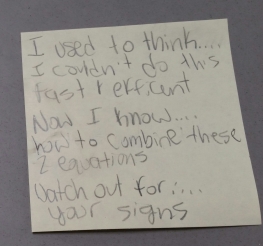So many thoughts this past week as we began Solving Systems in Algebra I which will likely lead to multiple posts…
Here is the Systems Organizer Student Assessment Tracker. I’m not satisfied with it yet, I’ve adjusted an old Algebra 2 unit, but I know by next year, this will be one of our strongest, most purposeful units.
I’ve been using the Candy Store problems since Mary and Alex shared them at TMC-Jenks. A great problem solving task with manipulatives to introduce systems of equations. My only change is to adjust for the U.S. candies, Solving systems CB S (Thanks for sharing your file, Mary!). I plan to bring in a candy treat to students to celebrate their journey when we end the unit.
Based on prior assessments, in class observations, I purposefully separated students on skill level for this unit. I intended it to be for me to have time to focus on groups with weaker algebra skills, while letting the others move on at their own pace. I pulled those few who tend to “do the work” into groups together which would allow for those who follow along in tasks or let someone else do the thinking, then they copy it down-be required to do their own thinking.
Here’s what I notice – my “algebra” kids struggle, my “struggling” kids soar – with the hands on task! It just goes to show, students do have good, strong reasoning skills when allowed to think on their own. Each group gets a cup of pennies and two different types of pattern blocks with a white board and marker – although I think next year, I will hold off on the white board and marker until AFTER they solve the first one – I really want them to rely on reasoning and number sense before trying to jump in and create equations…although that is the end goal.
The beginning was often guess and check, but I loved hearing their number reasoning as they progressed through the problems. Let me say, I have about 15 students spread between the 5 class who are still mad at me because they did not like the struggle. I just kept patting them on the back, asking questions and when they began to engage, I’d walk off and let them continue.
After most students experienced some level of success with the Candy Store problems, we reviewed/introduced linear combination (elimination) to solve systems when presented in Standard Form. I had examples ready, but as we practiced them on white boards as whole class, students were asking the questions:
- what if the terms match and aren’t opposite?
- what if nothing eliminates?
- why does multiplying the equation by a number work?
It was great when it was students asking and not me leading.
In their groups, they received 11 cards – with solutions on one side and system equations on the other. The cards were placed so all solutions were facing up and a start card. When everyone in the group had solved/verified, they located the solution and flipped the card to find a new system to solve.

Nothing more than a glorified worksheet – handwritten while waiting at my daughter’s piano lessons. But the discussions they were having as they solved on the whiteboards were so valuable…immediate feedback, peer assessment.
It was a good day. The first time since Christmas Break that I felt confident we were moving forward. (I know… its March.)
I’ve been trying to be more purposeful in ending class and allowing time for reflection. Students were asked to copy 2 of the problems into their INBs, solve and verify – basically creating their own notes / examples to refer back to.
Each student received a sticky note and was asked to complete the sentences:
- I used to think…
- Now, I know…
- Caution…watch out for…
And they placed them according to their level of confidence as they exited the room:

This was on Wednesday. I felt that they had built confidence, addressed common errors and misconceptions and had seen how the algebra could offer an efficient model in problem solving. Yet, I still had a few groups who were strong/quicker with number reasoning when solving them.



